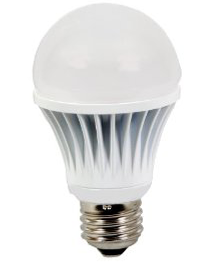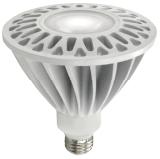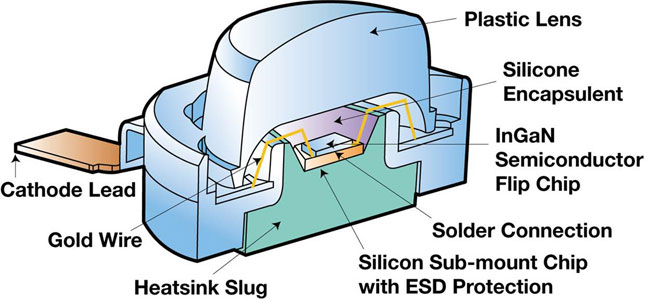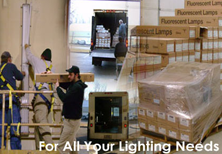LED Overview
Light Emitting Diodes (LEDs) have existed since the 1960s but only recently evolved to the point where they are useful in mainstream lighting applications. LED lighting is gaining popularity due to the growing energy conservation movement and advances in technology. LEDs are light sources with extremely long lifetimes, intense colors and high energy efficiencies. According to the U.S. Department of Energy, no other lighting technology offers as much potential to save energy and enhance the quality of our building environments as LED Lighting.

What is LED Lighting?
LED stands for Light Emitting Diode. It is a compound semiconductor device that converts electricity into light. One or more LEDS combined with a driver, housing and other components create an LED lighting system- either a lamp of a fixture.


Benefits of LED Lighting
- Energy efficient and environmentally friendly – LEDs only use a fraction of the electricity that is needed to power traditional light sources, they produce no UV rays and they are mercury and lead free.
- Longer life – LED lights have a rated life of 30,000 to 100,000 hours plus. Compare that to incandescent lights with a life of 1000 to 5000 hours, Compact Fluorescent (CFL) with a life of 8,000 to 10,000 hours and linear fluorescent 20,000 to 50,000 hours and you can see that LED lighting can save you a lot of money long term.
- Controllability – LED lighting is a perfect complement to occupancy sensors as LED’s life is not affected by the on/off cycles. In other words you can turn them on and off as much as you want.
- Turn on instantly – Even in cold weather, LEDs switch on instantly.
- Can be dimmed – LED lighting sources can be dimmed similarly to incandescent lighting. Which means you can dim LEDs down as much as 0.5% of potential light level.
- Range in colors – With advances in technology you can select LED Kelvin temperatures ranging from 2700 up to 6500 Kelvin (similar to fluorescent).
- Emit light in specific direction – No light is “lost” in the fixture or sent in a non-useful area with LED lighting.
- Small size – Since LED chips are relatively small they can be designed to fit in just about every type of existing light bulb shape.
- Efficacy – LED lighting is capable of offering well over 100 lumens per watt of energy consumed (efficacy). Most conventional lighting sources have efficacy levels of less than 100 lumens per watt.
- Durable – LED lighting is highly resistant to shock and vibration has excellent cold weather performance and contains no glass components.

Things to Consider with LED Lighting
Although LED’s aren’t practical for every application at this time, they are clearly the future of the lighting industry. Because of that there have been many LED manufacturers entering the market place. You will find varying claims and companies that will come and go. With that in mind it is important that you have proper guidance to make a decision that will mean the difference between a superior, long-lasting LED lighting solution and an underperforming, expensive failure. The difference is knowing the technology and that’s where Premier Lighting can help. There are literally thousands of LED products to choose from at varying price levels and with that comes varying performance results.
While all of these checklist items are not necessary for all applications, here are some items you need to consider when making a decision on a LED lighting product:
- What are you trying to replace?
While many LED products can save energy and provide high quality lighting, some of them fail to match the performance of the technologies they’re designed to replace.
- Is the manufacturer reputable and do they have a track record of lighting/LED experience?
With so many new LED lighting products and manufacturers coming onto the market, it’s not always easy to sort the good from the bad.
- Does it have LM-79 photometric reports and IES files from an independent testing lab?
LM-79 establishes testing methodology to create a level field for LED product evaluation.
- Is the LED dimmable?
If it is and you need it to dim, make sure you check compatibility of the LED product with your current dimming system.
- Does it have a LED Lighting Facts Label?
The LED Lighting Facts® is a program of the U.S. Department of Energy that showcases LED products for general illumination from manufacturers who commit to testing products and reporting performance results according to industry standards.
- Is the entire product backed by warranty?
Some manufacturers only warranty a portion of the product, for example they warranty the LED chip and not the LED driver. Make sure you have a comprehensive warranty.
- Is it commercial grade or residential grade?
There are many LED products being introduced and sold in the big box retailers, but there is a difference in performance and price. In other words, you get what you pay for with LED.
- Does it have an Energy Star Rating?
ENERGY STAR is the trusted, government-backed symbol for energy efficiency designed to make it easy for consumers to identify and purchase energy-efficient products that offer savings on energy bills without sacrificing performance, features, and comfort.
- Has LM-80 testing been performed by your LED or LED module manufacturer?
LEDs do not fail like conventional lighting sources. Their life is measured by a rating called L70. The lighting industry has determined that the end of life of LED products is when the lumen output is 70% of its initial output (30% depreciation). Since LED’s last so long and advance rapidly it is impossible to test them for their rated life so LM-80 was created as a test to determine light output after 6,000 hours of testing.
LED’s Future
LED is the lighting technology of the future. It is estimated that switching to LED lighting over the next two decades could save the country $250 billion in energy costs over that period, reduce the electricity consumption for lighting by nearly one half, and avoid 1,800 million metric tons of carbon emission. Because of the endless potential with LED lighting it is here to stay and will be an important part of the lighting industry for years to come.
Premier Lighting’s LEDs
LEDs have the potential to provide huge energy savings and years of beautiful light; however, the results you experience largely depend on the quality of LED products and light fixtures you choose. For those reasons, Premier Lighting only carries the highest-grade fixtures and Energy Star certified LEDs. Our trained technicians install all materials to the highest of industry standards, so you always get the full value from your investment.
We serve locations nationwide and keep a wide variety of LEDs in stock for virtually any application. Contact us today for more LED information or head to our online LED store to learn about our products.



